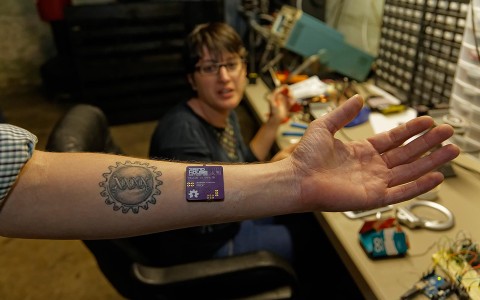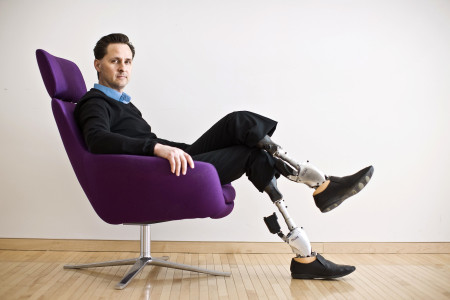With titles such as Deus Ex: Mankind Divided, and now the suspiciously similar Call of Duty Black Ops 3, featuring the next level of human evolution, it begs the question would YOU become a cyborg?
In the fictional world of Deus Ex, humans have advanced enough technologically to augment their bodies. These augmentations have made humans stronger, faster, given them new ways to see and hear, and are meant to improve quality of life. But along the way, these works of scientific wonder are abused, and manipulated. A huge conflict within this world is the question of whether or not humans should augment themselves, just because they can.
 In reality, humans have begun this process in a different way, to aid those who have lost their limbs, in an effort to help recuperate. Prosthetics, up until recently, have been overly expensive and uncomfortable. These stiff, unmoving replicas of human hands rarely helped the wearer simulate natural actions. This time is coming to an end, as prosthetics have become cheaper, and much more advanced thanks to 3D printing technology. One group, e-Nable, provides cheap 3D prosthetics and schematics to patients across the globe. These highly functional and durable designs help those who may not have otherwise been able to afford prosthetics.
In reality, humans have begun this process in a different way, to aid those who have lost their limbs, in an effort to help recuperate. Prosthetics, up until recently, have been overly expensive and uncomfortable. These stiff, unmoving replicas of human hands rarely helped the wearer simulate natural actions. This time is coming to an end, as prosthetics have become cheaper, and much more advanced thanks to 3D printing technology. One group, e-Nable, provides cheap 3D prosthetics and schematics to patients across the globe. These highly functional and durable designs help those who may not have otherwise been able to afford prosthetics.
Many 3D printed prosthetics do not emulate full range of motion. While they do enhance the quality of living for millions across the globe, even more advanced prosthetic devices are being created. At MIT, Biomechatronics Group is developing bionic legs that react to the users thoughts, moving at will. The Group’s highly developed bionic legs called BIOM’s, use sensors and motors to replicate the contraction of human muscle as its users walk. This bionic propulsion helps users not only get around, but walk as if they were their natural limbs. Using electrodes placed on the ends of residual limbs, pulses from the wearers muscles are communicated to the bionic limb, allowing it to move at the users will.
Biomechatronics Group is not only set on helping those who have lost their limbs due to disease or accident, but their eyes are set on the future. The second half of their mission statement is to “ develop technologies that augment human performance beyond what nature intends”. The group has already publicly shown exoskeletons that assist in activities such as long distance walking and running. By applying the appropriate torque and power while walking, the users own legs need not apply these forces, saving energy. Other exoskeletons are used to reduce the impact on the joints caused by running.
Another highly popular prosthesis is the DEKA arm, sometimes called the “Luke arm”. This mechanical arm can also be manipulated by the wearer’s thoughts, and is capable of multiple  movements at a time. A similar system as the BIOM legs are used to transmit pulses to a processor, allowing use to feel real and natural.
movements at a time. A similar system as the BIOM legs are used to transmit pulses to a processor, allowing use to feel real and natural.
“Body Hacking” has been coined as a term for those who have taken their technological tinkering ways to their own bodies. One of the most popular and simple body hacks is the magnetic implant. By implanting a small magnet just beneath the skin on a fingertips, users can pick up tiny magnetic objects, and sense magnetic fields. This practice has grown over the years and may even lead to ways for the blind to see once again. By attaching sensors to your implant, that cause it to vibrate or react to say infrared light, using a small device that shoots beams of infrared light can be used to find objects, or sense whether they are coming closer to you or moving away. A team of body hackers known as Grindhouse Wetware, has developed such a module already.
 They are also working on other projects such as Circadia, an implanted device that will transmit your biomedical to a computer via the internet. This can aid in diagnosing disease, speedup healthcare, or even for general consumers. The eventual idea is to allow the device to recieve messages, alerts, or texts to also be viewable through your own skin with LED’s mounted on the device. Other devices they have planned seem mostly cosmetic such as the Northstar, a device implanted in the palm. It will feature LEDs that can light up in patterns through the skin.
They are also working on other projects such as Circadia, an implanted device that will transmit your biomedical to a computer via the internet. This can aid in diagnosing disease, speedup healthcare, or even for general consumers. The eventual idea is to allow the device to recieve messages, alerts, or texts to also be viewable through your own skin with LED’s mounted on the device. Other devices they have planned seem mostly cosmetic such as the Northstar, a device implanted in the palm. It will feature LEDs that can light up in patterns through the skin.
New ideas and devices emerge every day. Inventions like tattoos with embedded sensors used to monitor vital signs, or antennas implanted in your body that help you see different spectrums of light may one day be a reality. These new forms of human evolution pose some interesting questions to humanity. With the ability to become anything, what will we become? Will augmentation be something only available to the rich? Will it become just another consumer product that envelops all of our time and attention? What spiritual implications does this pose to some? Will this be used against us?
Many fear that things like RFID chips will be used to track and surveil citizens who have them. Even though RFID chips can only be read from inches away, this does pose an important question. If we open ourselves up to the vulnerabilities of a computer by essentially turning our body into one, how can that be manipulated? Is that risk worth it? Would you take that risk?


